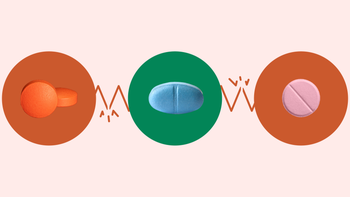
Ibuprofen, Naproxen, and More: The 8 Most Common NSAIDs
Key takeaways:
Nonsteroidal anti-inflammatory drugs (NSAIDs) are effective for treating inflammation and various types of painful conditions. Some are available over the counter (OTC), while others require a prescription.
Common OTC NSAIDs include ibuprofen (Advil, Motrin) and naproxen (Aleve). Meloxicam (Mobic), diclofenac (Voltaren, Cambia), and celecoxib (Celebrex) are popular prescription NSAIDs.
There are many ways to save on OTC and prescription NSAIDs. Many of these medications are available as lower-cost generics and have copay savings opportunities. GoodRx can help make your OTC and prescription NSAIDs more affordable.
Table of contents
Dealing with aches and pains can be a drag. Fortunately, there are many medication options to help. Nonsteroidal anti-inflammatory drugs (NSAIDs) are a popular choice for treating pain.
You’ve likely heard of the most popular NSAIDs (and might have one or more of them in your medicine cabinet). But there are many different NSAIDs available. Some are available over the counter (OTC) and others by prescription only. A few have both OTC and prescription forms. Below, we discuss these pain relievers and provide a list of eight common NSAIDs.
What are NSAID drugs and how do they work?
NSAIDs are a type of pain reliever. They can also help reduce fever and inflammation. NSAIDs work by blocking cyclooxygenase (COX), a protein that makes prostaglandins. Prostaglandins are one of the chemicals responsible for pain and inflammation (swelling). A lower level of prostaglandins often means less pain. This is why NSAIDs work well for painful or inflammatory conditions, such as rheumatoid arthritis and osteoarthritis.
Search and compare options
NSAIDs examples
There are many examples of NSAIDs. The easiest way to think about them is by separating prescription NSAIDs from those available OTC.
Prescription NSAIDs include:
Celecoxib (Celebrex)
Diflunisal
Etodolac
Fenoprofen (Nalfon)
Flurbiprofen
Indomethacin (Indocin)
Ketoprofen
Ketorolac
Mefenamic acid (Ponstel)
Meloxicam (Mobic)
Nabumetone
Oxaprozin (Daypro, Coxanto)
Piroxicam (Feldene)
Sulindac
Tolmetin
Most forms of diclofenac (Cambia, Flector, Pennsaid)
Higher doses of ibuprofen (Advil, Motrin)
Higher doses and liquid forms of naproxen (Aleve, Naprosyn)
NSAIDs available OTC include:
Aspirin
Low doses of ibuprofen
Low doses of naproxen
Diclofenac 1% gel (Voltaren Arthritis Pain Relief)
Below, you’ll find our more detailed NSAID list, covering eight common medications in this class.
Read more like this
Explore these related articles, suggested for readers like you.
1. Ibuprofen (Advil, Motrin)
Ibuprofen (Advil, Motrin) is one of the most well-known NSAIDs on this list. It’s available both OTC and by prescription. OTC ibuprofen comes in a lower dose (200 mg pills and a 100 mg/5 mL liquid) and treats fever and minor aches and pains. Prescription-strength ibuprofen (400 mg and higher) is FDA approved to treat the following conditions:
Dysmenorrhea (painful menstrual cramps)
Mild to moderate pain
Oral ibuprofen is available in both pills and liquids. And it’s safe for children as young as 6 months old to take.
The effects of ibuprofen don't last very long in the body. Lower doses may need to be taken every 4 to 6 hours. Higher doses may need to be taken every 6 to 8 hours.
2. Naproxen (Aleve, Naprosyn)
Naproxen (Aleve, Naprosyn) is available OTC as 220 mg oral pills. It’s labeled to treat fever and minor aches and pains for people ages 12 years and older. Higher-dose pills (250 mg and higher) and liquid naproxen are available by prescription only. Prescription naproxen is approved to treat more health conditions than the OTC version.
Prescription naproxen can treat the following conditions:
Rheumatoid arthritis
Osteoarthritis
Dysmenorrhea
Mild to moderate pain
Compared with ibuprofen, a dose of naproxen lasts longer — up to 12 hours.
3. Aspirin
Aspirin has been around for over a hundred years. It used to be a popular choice for treating pain. But over the years newer NSAIDs have become the go-to for that purpose. Nowadays, aspirin is often taken at low doses (100 mg and lower) for heart protection.
Aspirin is available in tablet form. Some are enteric coated to reduce stomach irritation. It’s also available in chewable tablets, oral capsules (Vazalore), and rectal suppositories.
Aspirin can cause Reye’s syndrome in children and teens under 19 years old. This is a rare condition that can cause life-threatening brain swelling and organ damage. Don’t give aspirin to your child or teenager without a medical professional’s OK.
4. Meloxicam (Mobic)
Meloxicam (Mobic) is a prescription NSAID. It has fewer FDA-approved uses than other NSAIDs, but is approved to treat:
Osteoarthritis in adults
Rheumatoid arthritis in adults
Juvenile idiopathic arthritis in children
Meloxicam is available as a capsule, tablet, and oral liquid. It’s a convenient option because you typically only take it once a day.
5. Diclofenac (Voltaren Gel, Cambia)
Diclofenac is another well-known NSAID. All of the dosage forms except one (1% topical gel) are only available with a prescription. Different forms of diclofenac are FDA-approved to treat different conditions:
Diclofenac sodium delayed-release (DR) tablets: Osteoarthritis, rheumatoid arthritis, and ankylosing spondylitis in adults
Diclofenac sodium extended-release (ER) tablets: Osteoarthritis and rheumatoid arthritis in adults
Diclofenac potassium capsules (Zipsor): Mild to moderate pain in people ages 12 years and older
Diclofenac potassium tablets (Cataflam, Lofena): Osteoarthritis, rheumatoid arthritis, and mild to moderate pain in adults
Diclofenac potassium powder (Cambia): Migraine attacks in adults
Diclofenac capsules (Zorvolex): Osteoarthritis and mild to moderate pain in adults
OTC diclofenac 1% gel (Voltaren): Osteoarthritis joint pain
Diclofenac 1.5% and 2% topical solutions: Osteoarthritis knee pain
Diclofenac 3% gel: Actinic keratoses (abnormal skin growths)
Diclofenac patch (Flector): Pain from minor strains, sprains, and bruises
Diclofenac eye drops: Pain or sensitivity after cataract or corneal surgery
One of the pros of diclofenac is how many forms are available. Topical forms, such as gels and patches, can help limit side effects and interactions with other medications.
There are some downsides, though. Both the gel and patch can take several days to provide relief. Plus they aren’t approved to treat arthritis in the back or hips.
6. Celecoxib (Celebrex)
Celecoxib is a prescription NSAID that comes as an oral capsule (brand name Celebrex) and as a liquid (brand name Elyxyb). The liquid is only FDA approved to treat migraines. But the capsule form is approved for several other uses:
Osteoarthritis
Rheumatoid arthritis
Ankylosing spondylitis
Dysmenorrhea
Juvenile rheumatoid arthritis in children 2 years and older
Short-term treatment of other painful conditions
Celecoxib works a little differently than the other NSAIDs, so it’s less likely to cause stomach ulcers or bleeding. But it’s also linked to a higher risk of heart problems than many other NSAIDs. Your healthcare provider may recommend avoiding it if you have a history of heart disease, heart attacks, or strokes, or if you have a high risk of developing heart disease.
7. Ketorolac
Ketorolac is a very powerful prescription NSAID. It’s intended for the short-term treatment (5 days or less) of moderate to severe pain. In some cases, it may be prescribed instead of an opioid. Your first dose may be an injection given in a hospital or healthcare facility. Ketorolac can then be continued at home in the form of oral tablets or a nasal spray (brand name Sprix).
Ketorolac eye drops (Acular, Acuvail) are prescribed for pain and inflammation after cataract or cornea surgery. They can also help with itchy eyes caused by allergies, but they’re not a first-choice treatment for this issue.
8. Indomethacin (Indocin)
Indomethacin (Indocin) is another prescription NSAID. It comes in oral capsules, an oral liquid, and rectal suppositories. There’s also an injectable version that’s used in healthcare settings.
Indomethacin is FDA approved to treat:
Rheumatoid arthritis
Osteoarthritis
Ankylosing spondylitis
Shoulder pain due to bursitis or tendinitis
Gout attack (all forms except indomethacin ER capsules)
Indomethacin is a go-to prescription NSAID for some medical professionals when treating gout attacks. But studies suggest other NSAIDs are similarly effective for this use.
Is there a strongest or weakest NSAID?
Clinically speaking, there’s no “strongest” or “weakest” NSAID. Everyone’s perception of how well a medication works for them is unique. But some NSAIDs last longer in the body than others. This means you don’t need to take them as frequently. But it doesn’t necessarily mean you’ll find it more effective than NSAIDs that don’t last as long.
Some NSAIDs also have a greater risk of side effects. For instance, ketorolac has a higher risk of kidney and stomach damage than other NSAIDs. That’s why you should only take it for a maximum of 5 days.
Speak with your medical care team about which NSAID might be the best option for you. They’ll weigh the pros and cons of each before deciding.
What are the side effects of NSAIDs?
NSAIDs have a number of potential side effects. And some can be pretty serious. That’s why the FDA recommends taking the lowest possible dose for the shortest time needed.
Common NSAID side effects include:
Nausea
Heartburn
Vomiting
Gas
Stomach pain
Diarrhea
Constipation
Swelling, particularly of the legs or ankles
More serious NSAID side effects include:
A higher risk of having a heart attack or stroke
Raised blood pressure
Stomach injury, including ulcers or bleeding
A higher risk of bleeding, especially if you also take blood thinners
How to save on NSAIDs
There are many ways to save on OTC and prescription NSAIDs. GoodRx can help you navigate your options, which may include GoodRx discounts, copay savings cards, and patient assistance programs. You can find NSAID prices as low as about $4 with a free GoodRx discount. Keep in mind that you can also use GoodRx to save on OTC NSAIDs if your medical professional writes you a prescription for them.
The bottom line
Nonsteroidal anti-inflammatory drugs (NSAIDs) are a commonly recommended treatment for fever, pain, and inflammation. Over-the-counter NSAIDs include ibuprofen, naproxen, and aspirin. Popular prescription NSAIDs include meloxicam, ketorolac, and celecoxib. These pain relievers do have risks for side effects. So be sure to talk to your healthcare team about whether NSAIDs are right for you.
Why trust our experts?



References
Antman, E. M., et al. (2007). Use of nonsteroidal antiinflammatory drugs: An update for clinicians: A scientific statement from the American Heart Association. Circulation.
Arthritis Foundation. (n.d.). Juvenile idiopathic arthritis (JIA).
Bayer HealthCare LLC. (2023). Aleve- naproxen sodium capsule, liquid filled [package insert]. DailyMed.
Bryant Ranch Prepack. (2023). Indomethacin- indomethacin capsule, extended release [package insert].
Fresenius Kabi USA, LLC. (2023). Indomethacin injection, powder, lyophilized, for solution [package insert]. DailyMed.
Ghlichloo, I., et al. (2023). Nonsteroidal anti-inflammatory drugs (NSAIDs). StatPearls.
McCarberg, B. H., et al. (2010). Topical diclofenac epolamine patch 1.3% for treatment of acute pain caused by soft tissue injury. International Journal of Clinical Practice.
ScienceDirect. (n.d.). Enteric Coated Tablet.
Sneader, W. (2000). The discovery of aspirin: A reappraisal. BMJ: British Medical Journal.
U.S. Food and Drug Administration. (2018). FDA Drug Safety Communication: FDA strengthens warning that non-aspirin nonsteroidal anti-inflammatory drugs (NSAIDs) can cause heart attacks or strokes.
Van Durme, C. M. P. G., et al. (2014). Non‐steroidal anti‐inflammatory drugs for acute gout. Cochrane Database of Systematic Reviews.
Williams, C. H., et al. (2023). Bursitis. StatPearls.




























